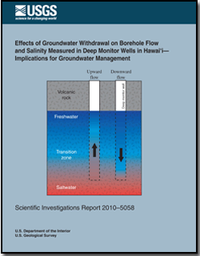Water-resource managers in Hawai`i rely heavily on salinity profiles from deep monitor wells to estimate the thickness of freshwater and the depth to the midpoint of the transition zone between freshwater and saltwater in freshwater-lens systems. The deep monitor wells are typically open boreholes below the water table and extend hundreds of feet below sea level. Because of possible borehole-flow effects, there is concern that salinity profiles measured in these wells may not accurately reflect the salinity distribution in the aquifer and consequently lead to misinterpretations that adversely affect water-resource management.
Steplike changes in salinity or temperature with depth in measured profiles from nonpumped deep monitor wells may be indicative of water moving within the well, and such changes are evident to some extent in all available profiles. The maximum vertical step length, or displacement, in measured profiles ranges from 7 to 644 feet. Vertical steps longer than 70 feet exceed the typical thickness of massive lava flows; they therefore cannot be attributed entirely to geologic structure and may be indicative of borehole flow. The longest vertical steps occur in monitor wells located in southern O'ahu, coinciding with the most heavily developed part of the aquifer.
Although regional groundwater withdrawals have caused a thinning of the freshwater lens over the past several decades, the measured midpoint of the transition zone in most deep monitor wells has shown only inconsequential depth displacement in direct response to short-term variations in withdrawals from nearby production wells. For profiles from some deep monitor wells, however, the depth of the measured top of the transition zone, indicated by a specific-conductance value of 1,000 microsiemens per centimeter, has risen several hundred feet in response to withdrawals from nearby production wells. For these deep monitor wells, monitoring the apparent top of the transition zone may not provide an accurate indication of water quality in the adjacent aquifer. Hence, the measured midpoint in boreholes is a better proxy for freshwater-lens thickness.
Brackish water transported upward in a deep monitor well can exit the borehole in the upper, freshwater part of the aquifer and affect the water quality in nearby production wells. Piezometers installed at different depths will provide the best information on aquifer salinity because they are unaffected by borehole flow. Despite the effects of borehole flow, monitoring the midpoint in deep monitor wells is still useful to identify long-term trends in the movement of the transition zone.


